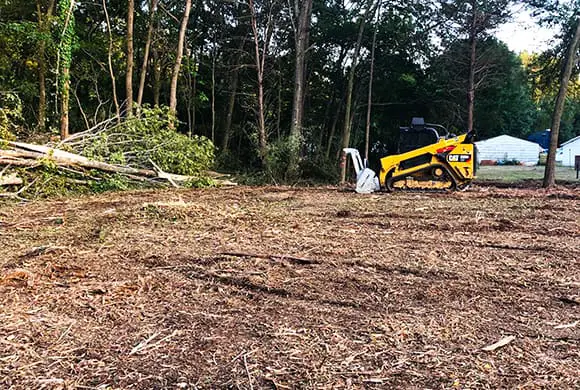Land Clearing for Construction: Is It Included in Loan and Tax Free?

Are you considering starting a construction project but are unsure about the costs of land clearing? Land clearing for construction is an essential step in preparing a piece of land for building, but it can be a costly and time-consuming process.
One question that often comes up is whether land clearing is included in loans and if it is tax-free. In this article, we’ll explore the answers to these questions, as well as the tax implications of land clearing, to help you make informed decisions about your construction project.
So grab a cup of coffee, sit back, and let’s dive into the world of land clearing for construction.
What is Land Clearing?
Land clearing involves removing vegetation, trees, rocks, and other obstacles from a plot of land to prepare it for construction. It can also include grading and leveling the land to create a suitable foundation for the building or infrastructure that will be erected on the site.
The extent of land clearing required varies depending on the size and location of the property and the type of construction project. Clearing land can be a costly process, but it is an essential step in ensuring that the project is completed on time and within budget.
Definition of Land Clearing for Construction
Land clearing is a crucial step in preparing a piece of land for construction. It involves removing any vegetation or obstacles that may be present on the site and ensuring that the land is level and free of any debris. This process is done to make the land suitable for building and to provide enough space for the infrastructure that will be necessary for the construction process.
Clearing the land of trees, shrubs, and other vegetation is typically the first step in land clearing for construction. This is necessary to make room for the building and any infrastructure that will be necessary, such as pipes, electrical lines, and sewer systems. Vegetation can also pose a fire hazard, especially in areas with dry weather conditions, so removing it can also help to mitigate that risk.
The removal of rocks, boulders, and other obstacles is another important aspect of land clearing for construction. These obstacles can interfere with the foundation of the building or even cause structural damage if they are not removed. Removing these obstacles can help to ensure the stability and safety of the structure and its occupants.
After the vegetation and obstacles are removed, grading is typically done to ensure that the land is level and properly sloped. Grading involves using heavy machinery to level the land and create the necessary slope to prevent water from pooling around the structure. Proper grading is essential to ensure the stability and longevity of the building.
Land clearing for construction may not be a one-time process. Depending on the location and the type of structure being built, ongoing land clearing may be necessary to maintain the stability and safety of the building. For example, if a structure is built on a hillside, ongoing land clearing may be necessary to prevent landslides or erosion.
It is important to understand the financial implications of this process. Land clearing is typically not included in loans or tax-free, meaning that the cost of land clearing will need to be factored into the budget for the construction project. The cost of land clearing can vary depending on a number of factors, including the size of the land, the type of vegetation that needs to be removed, and the amount of grading that needs to be done. It is important to get a clear estimate of the cost of land clearing before starting the construction process to ensure that you have enough funds to cover the expense.
Is Land Clearing for Consctruction Included in Loans?
If you are planning to build a property, you will likely require a loan to finance the construction. However, it is important to know which costs the loan covers and whether land clearing is included.
In most cases, land clearing is not included in the loan amount. This means that you will need to budget separately for land clearing and ensure that you have sufficient funds to cover this expense.
It’s crucial to take into account the cost of land clearing when budgeting for your construction project. The cost of land clearing will depend on several factors, including the size and location of the property, the type of vegetation and obstacles on the land, and the amount of grading and leveling required.
Tax Implications of Land Clearing
The tax implications of land clearing can vary depending on a number of factors, including the size and scope of the project, the methods used for clearing the land, and the environmental impact of the project. In general, there are two main tax-related considerations when it comes to land clearing: tax deductions and tax credits.
1. Tax Deductions for Land Clearing
Tax deductions for land clearing may be available in certain circumstances, such as when the land is being cleared for the purpose of agricultural production or for the development of a commercial or residential property. These deductions may apply to the costs associated with clearing the land, including the cost of equipment, labor, and materials.
In order to qualify for these deductions, the landowner must meet certain criteria and follow specific rules and regulations. For example, if the land is being cleared for agricultural purposes, the landowner must demonstrate that the cleared land will be used for agricultural production for a certain period of time.
If the land is being cleared for development, the landowner must provide evidence that the cleared land will be used for the purpose of constructing a building or other structure.
2. Tax Credits for Environmentally-Friendly Land Clearing Practices
In addition to tax deductions, there may also be tax credits available for environmentally-friendly land clearing practices. These credits are designed to encourage landowners to use sustainable and responsible methods for clearing land, such as low-impact equipment or replanting native vegetation.
The availability and amount of these tax credits can vary depending on a number of factors, including the location of the land, the size of the project, and the specific practices being used. Landowners should consult with their tax professionals to determine whether they are eligible for these credits and how they can be applied to their tax liability.
Other Considerations
When it comes to land clearing, there are several other considerations to keep in mind. These include:
1. Environmental Impact
Land clearing can have a significant impact on the environment. It is important to consider the environmental impact of land clearing and take steps to mitigate any negative effects.
This may include replanting trees and vegetation, using environmentally friendly equipment and techniques, and minimizing the amount of land cleared where possible.
2. Permits and Regulations
In many cases, you will need to obtain permits and comply with regulations when clearing land for construction. These regulations can vary depending on the location and type of construction project.
It is essential to understand the regulations in your area and ensure that you obtain all the necessary permits before starting any land clearing activities. Failure to comply with regulations can result in fines and delays in the construction process.
3. Cost and Budgeting
As mentioned earlier, land clearing can be a costly process. It is essential to budget appropriately and ensure that you have sufficient funds to cover the expense.
When budgeting for land clearing, it is important to consider all the factors that can impact the cost, including the size and location of the property, the type of vegetation and obstacles on the land, and the amount of grading and leveling required.
4. Safety
Land clearing can be a dangerous activity. It is important to take appropriate safety measures to ensure that no one is injured during the process.
This may include using safety equipment, such as helmets, gloves, and safety glasses, and ensuring that all equipment is well-maintained and in good working condition. It is also important to follow all safety protocols and procedures to minimize the risk of accidents or injuries.
5. Hiring a Professional
If you are not experienced in land clearing, it is advisable to hire a professional to do the job for you. A professional land clearing company will have the expertise, equipment, and safety protocols to ensure that the land is cleared safely and efficiently.
Hiring a professional can also save you time and money in the long run, as they will be able to complete the job faster and with greater accuracy than if you were to do it yourself.
Conclusion
Land clearing is an essential step in preparing a property for construction. While it can be a costly process, it is important to ensure that you have sufficient funds to cover the expense.
When it comes to loans and taxes, land clearing is not typically included in the loan amount and may not be tax-deductible. It is important to consult with a tax professional to understand the tax implications in your specific situation.
Other considerations when it comes to land clearing include the environmental impact, permits and regulations, cost and budgeting, safety, and the option of hiring a professional.
By taking these factors into consideration and planning accordingly, you can ensure that your land is cleared safely and efficiently, and that your construction project is completed on time and within budget.






